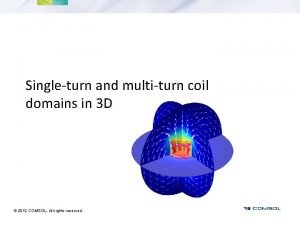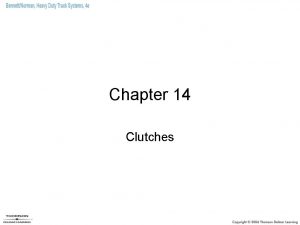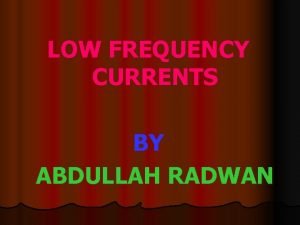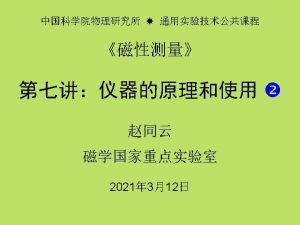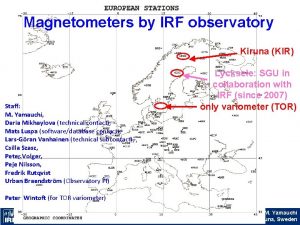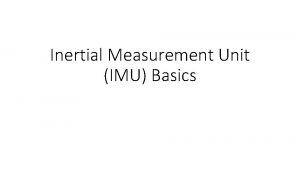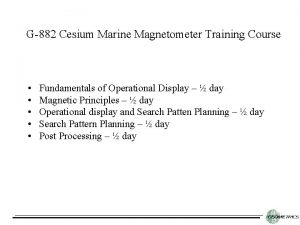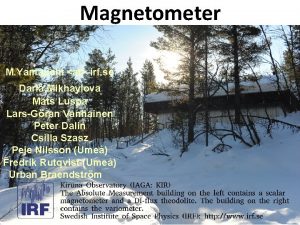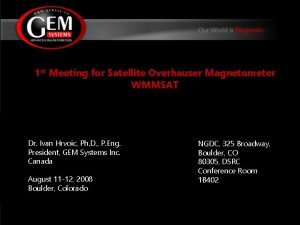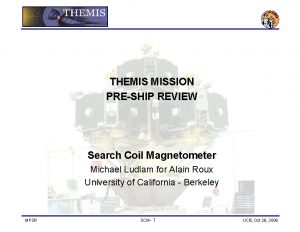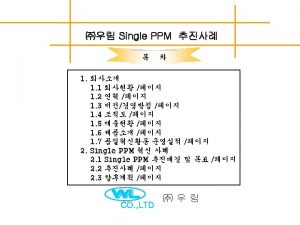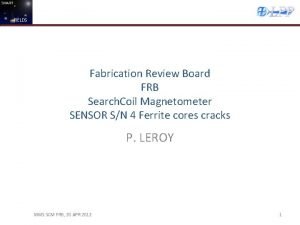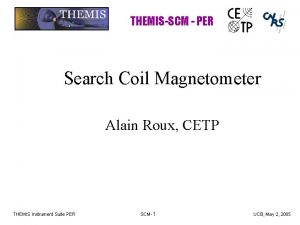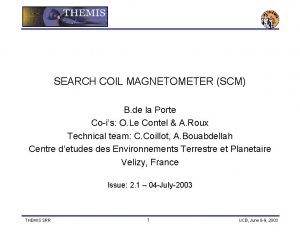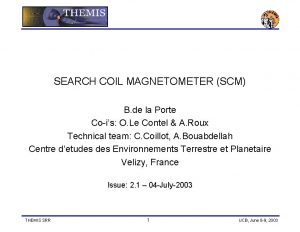THEMIS SCIENCE WORKING TEAM MEETING Search Coil Magnetometer









- Slides: 9

THEMIS SCIENCE WORKING TEAM MEETING Search Coil Magnetometer (SCM) team Co-i: A. Roux, O. Le Contel Technical Manager(*): C. Coillot Lead Engineer: A. Bouabdellah Technicians: D. Alison & S. Ruocco Software Engineers: P. Robert & (X) (*) SCM team thanks Bertrand de la Porte who was the first technical manager and for his continuing support. CETP-Vélizy, France SWG Template- 1 UCB, Nov 15/16, 2006

SCM objectives • • SWG SCM will measure the magnetic components of waves associated with substorm breakup. Wave signature is essential to identify the mechanism responsible for triggering breakup. Wave signatures are also expected to play a critical role in plasma transport through the magnetotail and across the magnetopause. Template- 2 UCB, Nov 15/16, 2006

SCM overview (I) • The SCM 3 -axis antennas are located at the end of 1 meter SCM boom • Magnetic components: 3 analogs signals from 0. 1 Hz to 4 k. Hz. • Sensitivity: 0. 8 p. T/ Hz@10 Hz; 0. 02 p. T/ Hz@1 k. Hz • Weight: 570 g • Pre-amplifier (in 3 D technology), located inside s/c body. • Weight: 200 g • Power: 75 m. W PA + sensors: • First qualified at CETP (vibrations, thermal cycling) and then at UCB/JPL on s/c. • Fully calibrated at CETP quiet facility near Chambon la Forêt. SWG Template- 3 UCB, Nov 15/16, 2006

SCM overview (II) Calibration mode • A Triangular signal generated by the PA and applied to a feedback winding installed in each antenna. • Once per orbit a calibration is run for 30 seconds (default). • After 60 seconds, the calibration is automatically turned off. Operation modes IDPU Data type # Comp. # Frequencies APID Sample rate S/s (nominal) Slow survey (SS) Relative allocation: 50% (12 h P 3, P 4, P 5) DFB filter banks 1 to 2 (1) 1 to 6 (6) 440 0. 0625 to 8 (0. 25) Fast survey (FS) DFB filter banks 1 to 2 (1) 1 to 6 (6) 440 0. 0625 to 8 (4) RA: 50 % (10, 8 h) DFB waveform 3 444 2 to 256 (8) Particle burst (PB) DFB waveform 3 448 2 to 256 (128) RA: 10% of FS (1, 2 h) DFB spectra (Bpara & Bperp) 1 to 4 (2) 44 D 0. 25 to 8 (1) Wave burst (WB) RA: 1% of PB (43 s) DFB waveform 3 44 C 512 to 16384 (8192) DFB spectra 1 to 4 (2) 44 F 0. 25 to 8 (8) SWG 16 to 64 (32) 16 to 64 (64) Template- 4 UCB, Nov 15/16, 2006

SCM calibration processing (I) Waves calibration method 1) get Level 1 SCM waveform (in Volts) 2) Select a time interval for calibration (Selecting this time interval is required to apply FFT and calibrate ) Single Calibration In sensor coordinates 3) Production of "clean" raw waveforms in the spinning Sensor Coordinate System (SCS) (substract sinusoidal wawe at spin frequency via a ‘desinus’ software ; requires the knowledge of the spin frequency) 4 ) Calibration of each component and conversion in n. T in the frequency domain (for the selected time interval) (FFT, Correction of tranfer function by *1/G(fi) ; cut-off at low frequency ) 5) Get calibrated time series data in n. T, in the spinning Sensor Coordinate System (SCS) (FFT -1) 6) Waveform transformation from SCS to Despun System Change to (Require Spin phase) Despun or other classical coordinate 7) Waveform transformation from SCS to GSE System, or others (GSM, MAG, GEO…) systems (Require Rocotlib software or other) SWG Template- 5 UCB, Nov 15/16, 2006

SCM calibration processing (II) Making use of calibration method SWG Template- 6 (Steps 1 -5) UCB, Nov 15/16, 2006

SCM science data (I) Physical quantities (L 2 data): In DSC (Despun System Coord. ), GSM and GSE coordinates • SWG • • FS waveforms (scf) of Bx, By, Bz [8 S/s; All. ~ 10. 8 h depending on which probe] PB waveforms (scp) [128 S/s; All. ~ 1. 2 h] WB waveforms (scw) [8192 S/s; All. ~ 43 s] • • • Filterbank data (fbk) [1 comp. ; 6 freq. ] throughout orbit PB spectra (ffp) [2 comp. ; 32 freq. ] WB spectra (ffw) [2 comp. ; 64 freq. ] Template- 7 UCB, Nov 15/16, 2006

SCM science data (II) L 2 subset: • • • Magnetic field aligned frame (MFA) Mininum variance frame (MVA) Polarisation analysis Using FFT and assuming . B =0 and k we can get the k direction and large and small ellipse axis directions z B 0 k k SWG Template- 8 k UCB, Nov 15/16, 2006

SCM comments Commissioning: • SCM should be turned on at the beginning in order to measure the noise generated by each instrument • SCM should be turned on with an operation mode allowing a good characterization of generated noise for instance with waveform at 256 S/s or may be short period at max. sample rate (16384 S/s) SWG Template- 9 UCB, Nov 15/16, 2006
